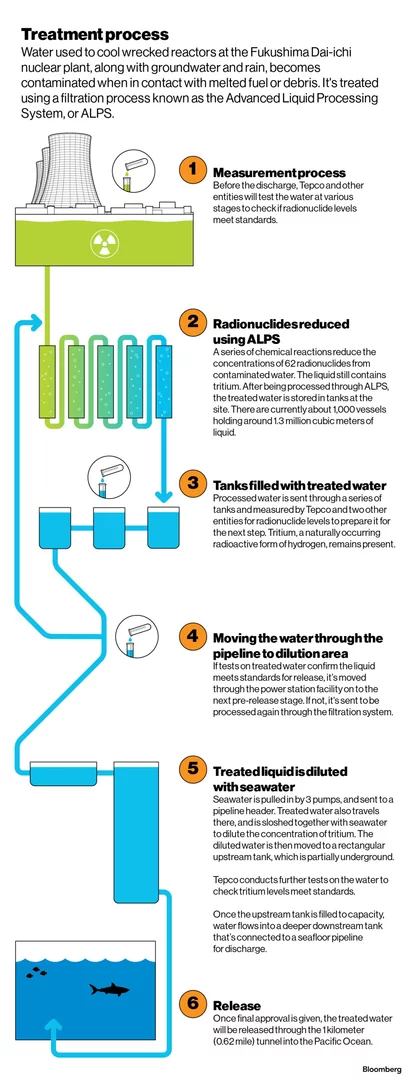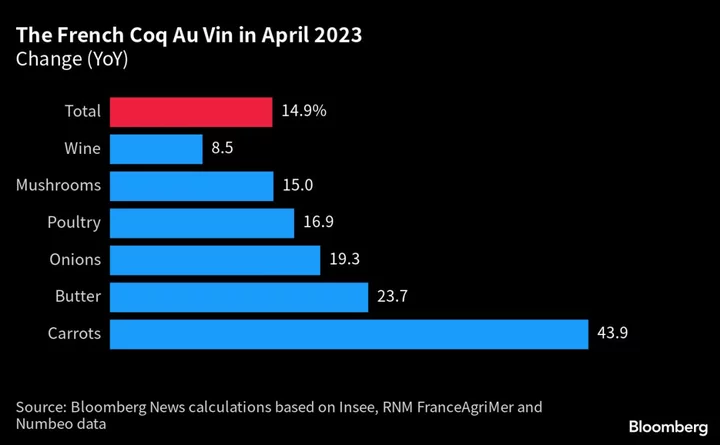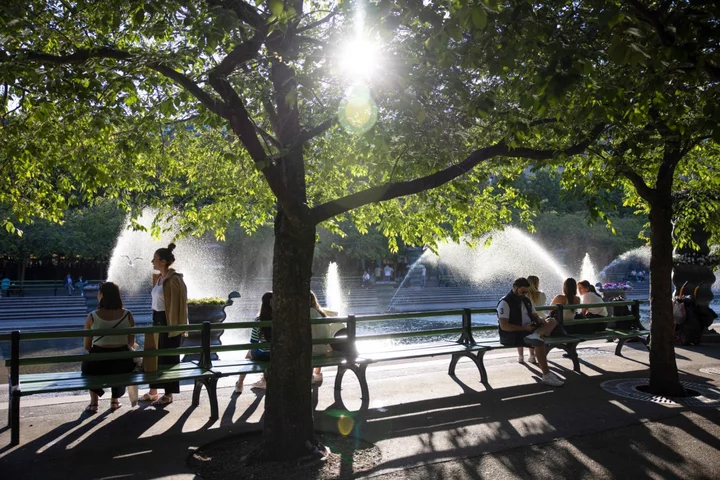Twisted sections of a reactor unit remain exposed at the Fukushima Dai-ichi nuclear plant and a crushed metal tank lies near the coastline, reminders of one of the world’s worst atomic disasters in 2011 and a response that’s already cost about 12 trillion yen ($83 billion).
Huge cranes are stationed across the site of Tokyo Electric Power Co.’s wrecked facility, while some areas have been covered with giant dome-like structures as work continues to manage the removal of dangerous fuel debris.
One of the most critical components of the current stage of decommissioning is much less obvious, a 10 centimeter (4 inch) wide pipe that funnels wastewater, in part generated as the stricken reactors are cooled, through a treatment process that will lead into the Pacific Ocean.
No element of Japan’s work to manage the risks from the disaster has been more contentious than its plan to start on Thursday discharging into the sea more than 1 million cubic meters of treated radioactive water — enough to fill 500 Olympic-size swimming pools — that’s currently stored in about 1,000 tanks.
Japan’s Prime Minister Fumio Kishida on Tuesday confirmed the process will start on Aug. 24 after a meeting of a cabinet panel. “If there are no issues with the weather and sea conditions, we expect the discharge to begin,” Kishida said. “The Japanese government will take responsibility to make sure the proposal is carried out safely, even if it takes decades until all of the treated water is discharged.”
Read more: Japan to Release Fukushima Wastewater From Aug. 24, PM Says
China has vociferously opposed the plans and threatened to extend curbs on imports of seafood, while Japanese companies including cosmetics brands have faced consumer boycotts. Restaurants in Hong Kong are already hurriedly seeking alternatives for the supply of some ingredients previously sourced from parts of Japan.
The ocean is “not Japan’s private sewer,” Chinese Foreign Ministry spokesman Wang Wenbin said in June.
Public protests have taken place in South Korea, despite the government’s backing for Japan’s strategy. Any problems would have “an impact not just on our three countries, but all countries around the world,” President Yoon Suk Yeol said Friday at Camp David, after holding talks with Kishida and US President Joe Biden.
Releasing the vast volumes of water is necessary as storage tanks are forecast to hit capacity early next year, and because the full decommissioning of the site doesn’t allow for more giant vessels to be added. Discharges of cooling water from nuclear plants are also common practice across the industry.
“Controlled, gradual discharges of the treated water” into the Pacific Ocean “would have a negligible radiological impact on people and the environment,” the International Atomic Energy Agency said last month, offering approval for Japan’s proposal after a two-year safety review.
Radiation levels at Fukushima have fallen over the past decade to the point that regular visitors are no longer required to wear full-body protective suits. Guests must still carry a dosimeter, and cover up with long sleeves, goggles, masks and gloves. Tepco also asks those accessing the site to undergo scans to check bodily radiation before and after their visit.
A tour of the facility held last month was part of Tepco’s efforts to respond to concerns about the planned releases by presenting evidence, according to Junichi Matsumoto, the company’s chief officer for the advanced liquid processing system water management. “We are aware that there are people with a variety of opinions about this plan,” he told reporters at the site.
The process that’ll be used over about the next 30 years to release batches of the treated water about 1 kilometer (0.62 miles) off the coast breaks down into four basic steps: measurement and confirmation, transfer, dilution and discharge.
Water is pumped into the facility and used to cool the damaged reactors. About 130 cubic meters of liquid — which also includes rain and groundwater — becomes contaminated each day after contact with nuclear fuel debris. It’s pumped out and processed through the advanced liquid processing system, or ALPS, which uses a series of chemical reactions to lower concentrations of 62 radionuclides.
That process can’t remove tritium, a weakly radioactive form of hydrogen. Though it can be carcinogenic at high levels, a human would need to ingest billions of units of becquerels — a measure for radioactivity — before seeing any health effects. Water released by Tepco will have a concentration of less than 1,500 becquerels per liter.
After the initial treatment, a first series of measurements of radionuclide levels are taken before the water is moved on to vessels where it’s mixed and circulated for 144 hours. Independent analysis company Kaken Co. and the Japan Atomic Energy Agency then begin a further testing process that can last about two months.
China has complained the IAEA didn’t evaluate the long-term effectiveness of Japan’s purification equipment, and has argued that waste from a nuclear accident — rather than from the usual operation of a power plant — hasn’t previously been handled in this manner.
“We hope that the public can be reassured by the fact that it takes a long time” for the treated water to clear protocols, Kenichi Takahara, a Fukushima-based risk communicator for Tepco, told reporters during last month’s visit. The process is also deliberately slow, because Tepco is capable of releasing at most about 500 cubic meters of treated water a day — a fraction of the 510,000 cubic meters of seawater brought into the facility every 24 hours.
At the dilution sector of the facility, three large pumps pull in seawater that’s combined with the treated liquid to ensure the tritium concentration is “well below” guidelines set by Japan’s government and the World Health Organization, according to Tepco. By the time the process is completed, the treated water will have been diluted more than 350 times, Tepco calculates.
That diluted liquid then moves into a partially underground tank for further sampling. In the next steps, water flows through a deeper vessel and then along the discharge tunnel — which runs for a kilometer under the seabed. A spout built roughly 12 meters below the sea surface will flush the water out into the Pacific.
Read more: Nuclear Power’s Revival Reaches the Home of the Last Meltdown
For Kishida, who is already struggling with waning popularity, placating both domestic and international concerns about the process is crucial, and particularly as Japan also seeks to bolster energy security by reviving the nation’s nuclear sector.
“The Japanese government, including myself, will continue to provide highly transparent explanations and information,” he said Sunday during a visit to Fukushima. His aim is to use “every opportunity to promote understanding, not only in China but also in the international community.”









